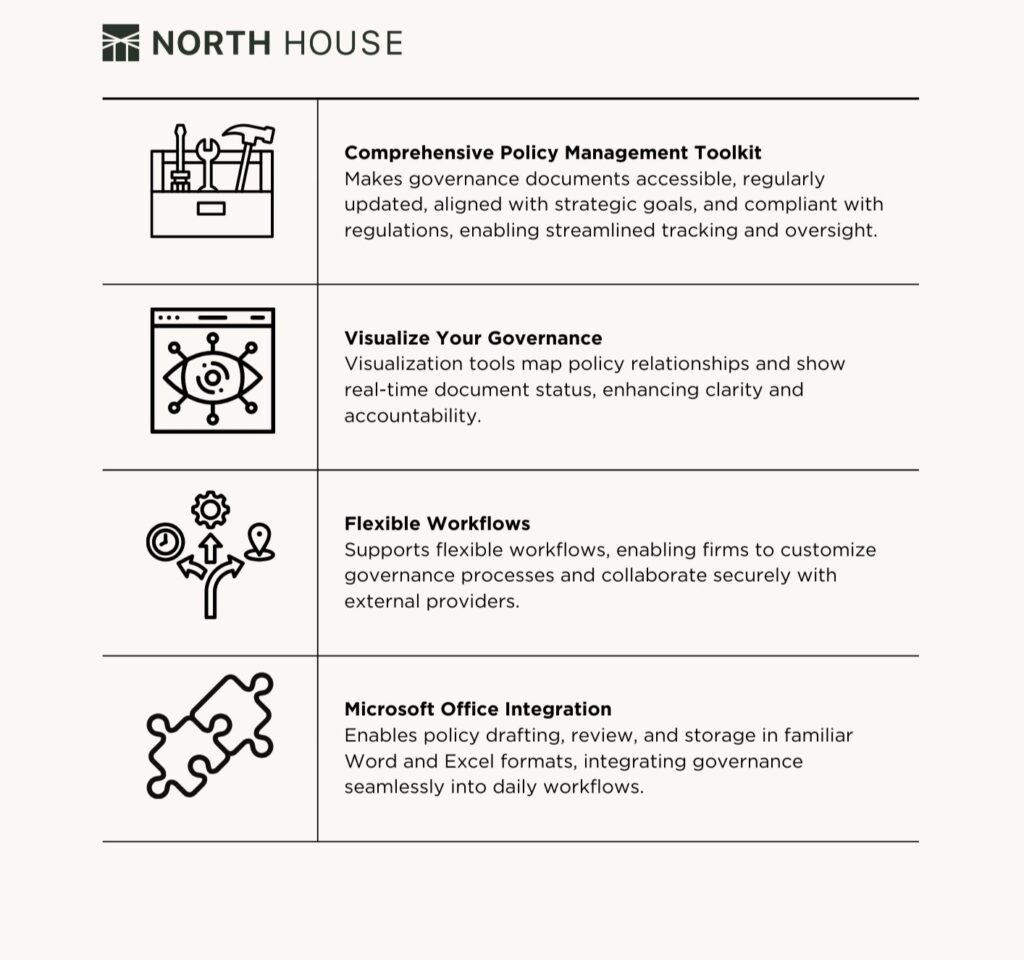By Sofia Beckman – North House: Over the past two decades, hedge funds have faced an increasingly complex regulatory landscape. Each wave of new regulation brings greater expectations for transparency and accountability, driven by regulatory bodies and investors. This “regulatory tsunami” impacts nearly every level of the organization, from strategic board decisions to daily tasks.
As regulatory pressures grow, the cost and complexity of compliance increase – exposing governance weaknesses, disrupting strategic planning, and adding to employees’ workload. Left unaddressed, this strain can weigh down company culture and hinder a firm’s agility in a highly competitive market.
CURRENT CHALLENGE AND IMPACT
In response to new regulations, firms have layered on policies and procedures. This has created a complex, disjointed governance framework that’s hard to manage and enforce. For fast-growing companies, scaling quickly while meeting evolving regulatory demands often results in an even more fragmented governance structure. Rather than providing clarity, this approach often creates inefficiencies and weakens organizational effectiveness.
This burden is acutely felt in the boardroom, where directors are tasked with steering the firm’s direction and managing strategic risks. However, mounting administrative demands have shifted their focus away from these priorities. Sofia Beckman, Co-Founder of North House, explains, “Boards are drowning in documentation and low-value approvals, leaving little bandwidth for strategic decision-making.” Instead of shaping the firm’s future and addressing critical risks, boards are mired in routine processes that stifle their effectiveness. To reclaim their strategic role, governance frameworks must streamline administrative tasks and refocus boards on oversight that drives long-term success.
The challenges also impact employees, who often struggle with outdated, unclear, or inaccessible policies. “As we’ve seen, employees struggle to engage with policies that resemble bureaucratic paperwork rather than practical guidance,” Beckman adds. “Beyond affecting job performance, it reduces compliance to a superficial box-ticking exercise, undermining its purpose. Employees may struggle to see it as a tool that genuinely supports their work.”
A lack of digital tools further compounds these issues. Compliance and legal tasks remain heavily dependent on manual work, lagging behind other functions in adopting technology. Industry estimates suggest that 50-70% of these tasks remain labor-intensive, requiring significant resources to keep documents current with regulatory standards. This manual approach raises costs and limits oversight, as outdated processes make tracking compliance challenging. Firms that outsource these tasks risk inheriting inefficiencies and potential compliance vulnerabilities if their vendors don’t prioritize digitalization and streamlined processes.
“With cost pressures mounting, firms need to view the compliance and legal area as critical expenses to control,” Beckman says. “In a fee-sensitive industry, managing these costs efficiently isn’t just beneficial—it’s a strategic necessity.”
Regulators are intensifying scrutiny, increasing sanctions, and requiring firms to demonstrate compliance in action—not just on paper. This shift makes it essential for firms to understand their compliance risks—often underestimated and difficult to quantify. As Beckman puts it “Digital transformation is key—within a few years, every firm will need simple, data-driven systems to handle these demands efficiently. For firms focused on cost control, adapting early can turn a costly challenge into an advantage, helping them stay resilient while managing expenses.”
BUILD A SCALABLE GOVERNANCE FRAMEWORK
Creating an adaptable, effective governance framework requires planning and investment. Here are essential steps to build a system that reduces manual work, controls costs, and promotes a proactive approach:
- Define Clear Policy Boundaries
Clearly distinguish between policies and procedures. Policies should address the “why” by outlining strategic goals, risk tolerance, and regulatory adherence, while procedures focus on the “how” of daily tasks. Appoint a Governance Process Owner to ensure policies are relevant, regularly reviewed, and aligned with organizational objectives. Adopt a “Policy of Policies” that include guidelines for structure, ownership, mandates, and standardized templates, as outlined in points 2 to 5 below. - Use Templates to Standardize
Standardized templates reduce legal jargon and improve accessibility, making it easier for employees to understand and follow policies. Consider offering “cheat sheet” versions for quick reference. - Empower Operational Leaders
Delegating operational tasks to the CEO and senior leaders allows the board to focus on strategic priorities. A strong example is AI: the board sets responsible use guidelines, while the CEO and teams implement these principles through clear instructions and training. This approach also works well in cybersecurity and data privacy, where the board’s principles shape operational procedures. - Assign Policy Ownership
Policy ownership should lie with senior managers who understand the business, not defaulting to legal or communications teams. This ensures policies are practical, relevant, and integrated into the organization’s operational context. For specialized areas, legal teams or external advisors can provide expertise efficiently, while operational leaders drive content and implementation. - Focus on Essentials
Every word carries a cost in time and effort, particularly for board members and employees who must read, interpret, and implement policies. Overly detailed or redundant language not only increases the burden but also risks diluting critical messages. Conciseness ensures that essential information is communicated clearly and efficiently, reducing the time required for comprehension and application. For example, a lengthy AML policy with every KYC step can become cumbersome. Instead, use a two-layered approach: maintain high-level policy guidance in one document and place detailed procedures in an instruction layer. - Streamline Distribution
Make policies easily accessible, and distribute only relevant ones to each role. Core policies, such as the Code of Conduct, IT Security, and AML, should be mandatory for all employees, with annual attestation to confirm understanding. Reinforce this approach with training initiatives to deepen engagement. - Invest in People and Tools
Building an effective governance framework begins with a strong foundation. Invest in skilled personnel and technology that automates and tracks key tasks. Competent personnel and modern tools create a governance system that is resilient and adaptable.
North House Platform

North House’s governance platform is purpose-built for regulated firms, offering hedge funds a structured solution that simplifies document management and strengthens transparency across the organization. Designed to foster collaboration and clear ownership, the platform simplifies delegated responsibilities. It streamlines document distribution and attestation, ensuring firms remain audit-ready. This digital framework enables firms to accelerate and simplify governance processes, fostering an efficient, organized structure that promotes both responsibility and transparency at every level.
This article is featured in HedgeNordic’s “(Em)Powering Hedge Funds” publication.
